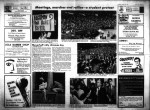University of California President Janet Napolitano’s job is safe for now, even after calls for her resignation last year. But 51 years ago, one UC president wasn’t so lucky with California politics.
On January 20, 1967, the UC Board of Regents voted 14 to 8 to fire then-UC President Clark Kerr. Regents’ reasons for voting to oust Kerr included a “lack of administrative ability,” “uncertainty in the University” and lack of confidence in Kerr. Among those who voted to fire Kerr was then-Governor and future President Ronald Reagan. Reagan had won the gubernatorial election only a few months earlier after running a campaign attacking UC administrators for their inaction on student protests and vowing to fire Kerr.
Tension between Reagan and Kerr over whether the UC should have a tuition (resident students did not have to pay a tuition back in the good old days) played a role in the vote. But hidden forces behind the ouster were unbelievably insane. The San Francisco Chronicle in 2002 unearthed FBI files showing that the bureau had orchestrated a campaign to get rid of Kerr because it disagreed with his stances. In addition, it had illegally harassed Regents with the help of the CIA.
The firing of Kerr provoked a strong reaction from the UCLA community – after all, he was the most popular figure in the UC among students according to a poll published by the Daily Bruin on January 25, 1967. The Bruin ran a front page editorial on Jan. 23, 1967 saying the UC could no longer depend on the Regents and the future of the institution lay in the hands of students. The editorial called for no implementation of a tuition and no budget cuts, and asked students to pursue “all non-violent means that the situation warrants.”
Among UCLA students, the reaction was generally one of shock. Karen Rubin, a third-year English student, said he thought Reagan should be impeached. “They don’t know a damn good thing when they have it,” said Lorne Dubin, a fourth-year psychology student. One student even went as far to muse that they would send their graduate application to USC.
But there were some supportive voices, too. Mario Savio, the leader of UC Berkeley’s Free Speech Movement in 1964, said “good riddance to bad garbage” (as opposed to good garbage). John Wayne, whose opinion on the state of California’s higher education was solicited for some reason, said Kerr was asking for it because he had made things rough on Reagan.
Three days after Kerr had been removed, UCLA students put on a massive display of their disapproval with the direction the UC was heading in. The Bruin reported on January 24, 1967, that 8,000 students gathered in the Memorial Activities Center Pavilion (now Pauley Pavilion) to protest Kerr’s dismissal, a UC budget cut and the possibility of a tuition.
Undergraduate President Bob Michael announced that four demands, including one against charging tuition, would be presented to the Regents. He referred to the firing as “the culmination of events leading to the downfall of the greatest of universities in the world.”
William Gerberding, a political science professor, was the voice of calm and restraint at the gathering. He told students they could honor Kerr by appealing to reason and freedom, without yielding to passion and demagoguery. He placed blame on Berkeley’s left-wing “radicals” for giving the radical right a platform to fire Kerr. Gerberding’s words drew a standing ovation.
Interestingly, the Daily Bruin apparently had zero editorial standards back then. Its very own editor-in-chief at the time, Neil Reichline, hit back at Gerberding’s remarks and criticized the UC and state politicians for falling back on their promises. “We know when we’ve been had – and we’ve been had!” Reichline said, and drew a standing ovation, according to the Bruin’s reporting on its own editor-in-chief.
Once the rally at the Pavilion was over, most students marched across campus to meet with then-Chancellor Franklin D. Murphy at the Administration Building (now, incidentally, known as Murphy Hall). Murphy, who was suffering from a viral infection at the time, was intermittently jeered at by students as he warned them, “Reason is only way the University can go ahead.”
From there, about 2,000 students headed towards Meyerhoff Park, where speakers discussed ways to counter Reagan’s proposals for the UC. Some students discussed ways to bridge the gap between militant students who wanted to boycott classes and more moderate students and faculty.
Student resentment also took more visual forms, most notably through the hanging of an effigy of Reagan from the third floor of Kerckhoff. A sign declaring “Fire the Regents” was wrapped around a garbage can on Bruin Walk. And students at the MAC Pavilion were on top of their sign game, with displays such as “Education Si, Tuition No,” “Students In – Politics Out,” “Recast Reagan,” “Stop the Purge” and “Whose Pavilion?”
Half a century later, UC resident students now pay $12,630 in tuition annually. And with a tuition hike possible again this year, it’s apparent all that marching and the Daily Bruin’s front-page editorial had minimal effect.
But at the very least, relations between the UC President and the governor are now much more cordial and disagreements over funding don’t flare into an all-out war. And hopefully, the CIA and the FBI aren’t colluding to harass Regents.
